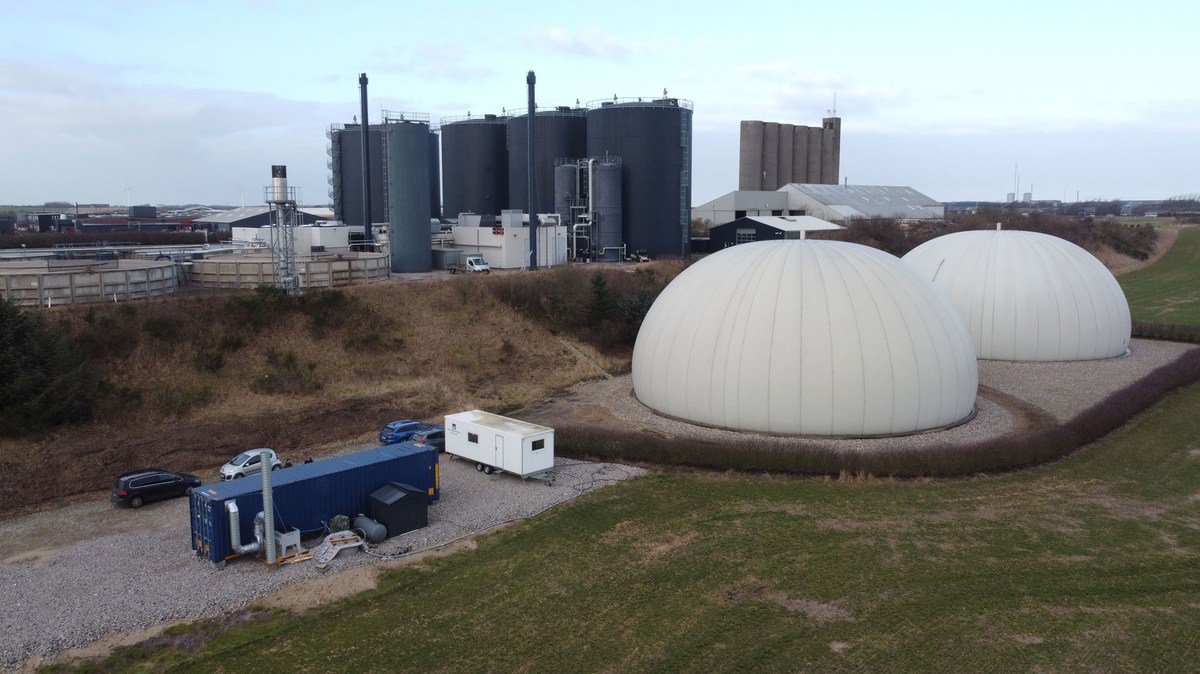Danish university finds low-cost method to produce bio-methanol
The Technical University of Denmark (DTU) claims its new technology to produce bio-methanol without adding extra hydrogen molecules will significantly reduce the cost of fuel production.
 PHOTO: Biogas is transported from Lemvig Biogas in the background to DTU's demonstration plant (white domes) and on to DTU's reactor (blue container). DTU
PHOTO: Biogas is transported from Lemvig Biogas in the background to DTU's demonstration plant (white domes) and on to DTU's reactor (blue container). DTU
Traditionally, bio-methanol is produced using sustainable biomass as a feedstock. Organic biomass is used to produce synthesis gas, which primarily consists of carbon monoxide, hydrogen and carbon dioxide (CO2), through a process called gasification. The syngas is upgraded to bio-methanol by further combining it with green hydrogen.
Now DTU has developed a technology that directly converts synthesis gas into methanol without the addition of extra green hydrogen. “Since hydrogen is produced by the formation of synthesis gas, there is no need to add hydrogen to produce methanol,” it notes.
“We take biogas and turn it into synthesis gas, and then we take the synthesis gas and turn it into methanol. And we have a plant that can recycle and use CO2 together with hydrogen and produce even more methanol,” Philip Fosbøl, associate professor at DTU’s department of chemical engineering explains. Fosbøl is one of the researchers involved in the project.
When fully developed, the technology can enable production of up to 60,000 mt/year of methanol. “The finished product consists of 95 per cent pure methanol, and 99.9 per cent can be achieved, if additional hydrogen from another source is added,” Fosbøl claimed.
Rising interest in methanol
Several shipping companies are investing in methanol-capable ships to include methanol into their future fuel mixes. This is expected to boost demand for green methanol as a bunker fuel in the coming years.
The International Chamber of Shipping estimated maritime demand for methanol to grow to 10 million mt/year by 2027, based on the methanol orderbook as of December last year. With vessel orders steadily increasing, this estimated number could rise even more in the coming years.
The total global methanol-fuelled fleet is currently only made up of 35 vessels. But it is set for fast growth, with another 269 expected to join the fleet by 2028, according to DNV data. Some shipping firms, like A.P. Moller-Maersk and X-Press Feeders, have already bunkered their methanol-capable vessels with bio-methanol.
Lowering the cost burden
Despite its growing popularity, a report by Lloyd’s Register (LR) predicted that the high bunkering cost of green methanol could be a potential stumbling block to its adoption in the coming years. According to LR, current market estimates suggest that a bio-methanol bunker stem in Europe or the US ports could average $1,300/mt between 2026-2040. After adjusting for calorific content, this amounts to $2,600/mt.
The LR report attributed the high prices to "feedstock prices, hydrogen costs, and electricity costs" indicating that they may gradually decrease with technological advances, but it may take some time. “Additional capital costs for producers such as electrolysis and plant investments need to be considered as well as subsequent transportation costs,” it added.
According to DTU researchers, their technology eliminates the additional costs associated with producing green hydrogen from electrolysis, which reduces the cost of bio-methanol production. The researchers also note that the method can be applied to smaller biogas plants that are located far away from hydrogen producers or not connected to gas grids.
By Konica Bhatt
Please get in touch with comments or additional info to news@engine.online





